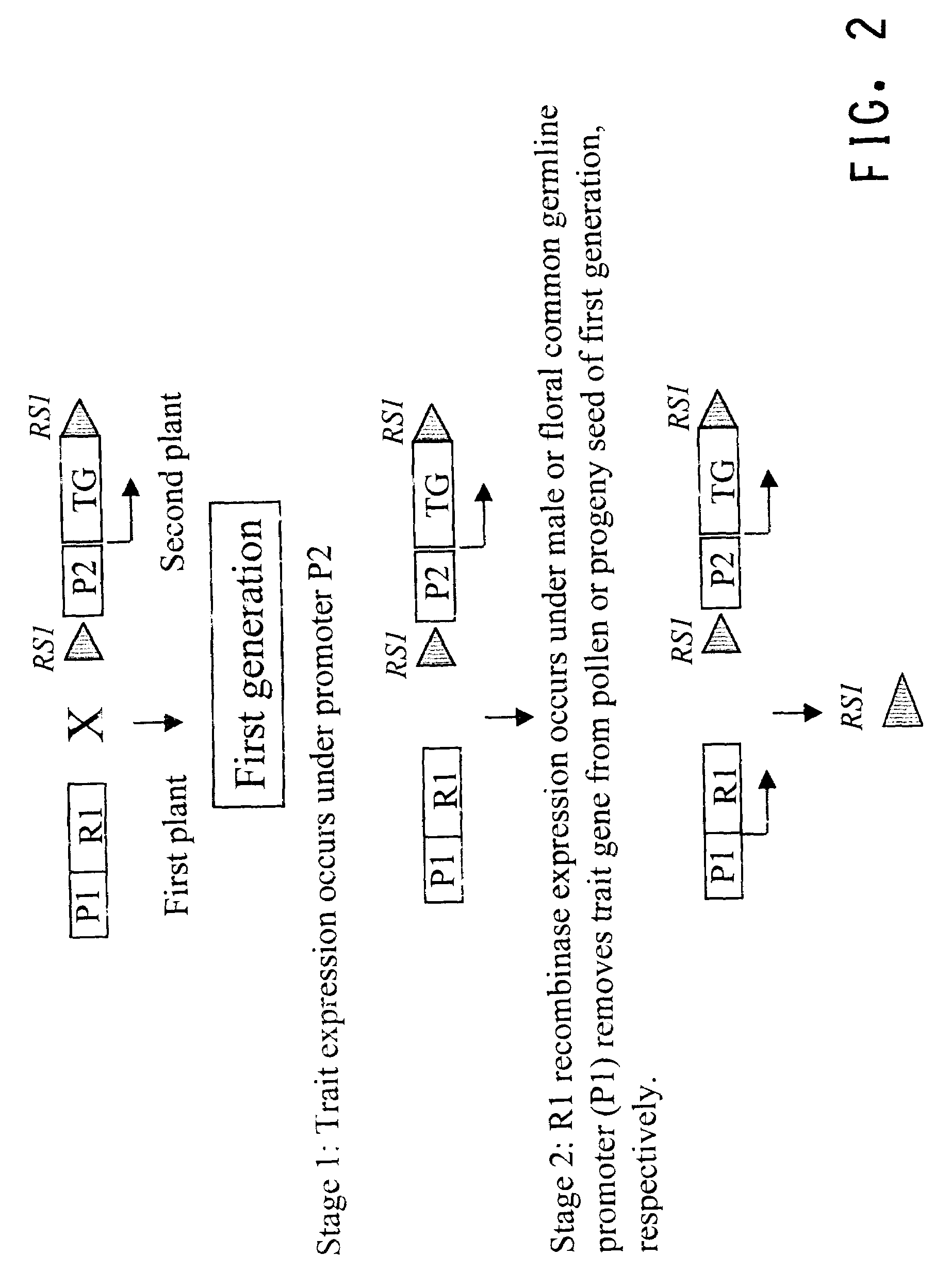Methods for regulated expression of triats in plants using multiple site-specific recombination systems
- Summary
- Abstract
- Description
- Claims
- Application Information
AI Technical Summary
Benefits of technology
Problems solved by technology
Method used
Image
Examples
example 1
Making an Excision Reporter in Binary Vector (pBE894) to Test Germline Specificity of Promoters
[0273]In order to identify male germline and common germline promoters, an excision reporter was made. In this reporter, the plant kanamycin resistance gene flanked by lox sites is inserted as a blocking fragment between a constitutive promoter and the luciferase coding region. The blocking fragment blocks the translation of luciferase by interrupting the luciferase coding sequence and such that upon cre lox excision, there is a single copy of lox site is left behind as a translational fusion with the Luciferase ORF that allows luciferase expression. The Cre gene under the control of regulated germline promoters is maintained outside the lox sites, i.e., not flanked by lox sites.
[0274]The excision reporter in binary plasmid, named pBE894, was made through the following intermediate plasmids:
[0275]pGV853 is 35S:Lox:yeast 2u:Lox:Luc (translational fusion). The coding sequence of luciferase w...
example 2
Identifying Promoters for Male and Common Germline Expression in Arabidopsis thaliana
[0286]The Xba I-Bam HI fragment of pBE894 carrying the SCP1 promoter was replaced by an Xba I-Bam HI fragment carrying one of several different developmentally-regulated promoters. These promoter regions, the PCR primers used to isolate them from genomic DNA of Arabidopsis, and the resultant binary plasmids are:
[0287]Promoter for Apetala 3 (AP3) gene from Arabidopsis thaliana Col. (pBE913).
[0288]Promoter for Bcp 1 (BCP 1) gene from Arabidopsis thaliana Col. (pBE914).
[0289]Promoter for Erecta (ER) gene from Arabidopsis thaliana Col. (pBE915).
[0290]Synthetic anther promoter (SAP) (pBE928) G9 / SGB6 hybrid promoter (U.S. Pat. Nos. 5,470,359; 5,837,850)
[0291]Promoter for Pistilata (PI) gene from Arabidopsis thaliana Col. (pBE929).
[0292]Promoter for TA29 from tobacco (Hsu, Francis C.; Odell, Joan Tellefsen; Shen, Jennie Bih Jien. Induction of male sterility in crop plants with heterologous genes expressed...
example 3
Identifying Promoters for Marker Excision in Common Germline in Tobacco
[0314]The Xba I-Bam HI fragment of pBE894 carrying the SCP1 promoter was replaced by an Xba I-Bam HI fragment carrying one of several different developmentally-regulated promoters. These promoters and the resultant binary plasmids are:
[0315]Promoter for Heat Shock (HSP) gene from Arabidopsis thaliana Col. (pBE917);
[0316]Safener inducible promoter, IN 2 (pBE927) described in PCT application WO 99 / 22003. Promoter for Apetala 1 (AP1) gene from Arabidopsis thaliana Col. (pBE913).
[0317]
Nucleotide positionsPCR PrimersPromoterLength(Genbank Accession #)UPLPTA291525 bp(from plasmid pTZALG)PH795PH815HSP18.2 (HSP) 926 bp50050–50975 (AB006705)PH806PH807Apetala 11850 bp27937–29807 (AC008262)P355P356(AP1)Agamous (AG)2999 bp48943–49528 (AL021711)P353P354Leafy (LFY)2287 bp 465–2752 (M91208)
Oligos used for PCR of promoters from Arabidopsis genomic DNA.
[0318]
AP1 PCR primersP355:5′-CGT CTA GAC CCG GGA TGT TGT CTT CAA GGC-3′(SEQ ID...
PUM
| Property | Measurement | Unit |
|---|---|---|
| Fraction | aaaaa | aaaaa |
| Fraction | aaaaa | aaaaa |
| Fraction | aaaaa | aaaaa |
Abstract
Description
Claims
Application Information
 Login to View More
Login to View More - R&D
- Intellectual Property
- Life Sciences
- Materials
- Tech Scout
- Unparalleled Data Quality
- Higher Quality Content
- 60% Fewer Hallucinations
Browse by: Latest US Patents, China's latest patents, Technical Efficacy Thesaurus, Application Domain, Technology Topic, Popular Technical Reports.
© 2025 PatSnap. All rights reserved.Legal|Privacy policy|Modern Slavery Act Transparency Statement|Sitemap|About US| Contact US: help@patsnap.com



